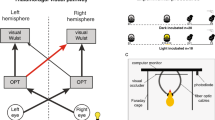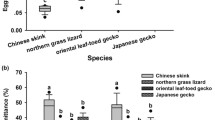Summary
Embryos of Peking ducks were either incubated in complete darkness up to hatching or were put into light one week before hatching. Control embryos were incubated under dim light conditions which corresponded broadly to the natural conditions. Under standardized imprinting conditions the controls and both groups of the light deprived ducklings showed the ‘following response’. Most of the dark-incubated embryos, however, did not distinguish between imprinting and test objects of different shapes. Since most of the embryos kept in darkness only for 21 days also failed to develop the capacity for shape discrimination, there is apparently a, critical period for light influences on the development of this capacity at some time during the early prenatal period.
Similar content being viewed by others
References
Blakemore, C., and Mitchell, D. E., Nature, Lond.241 (1974) 467.
Barlow, H. B., Nature, Lond.258 (1975) 199.
Daniels, J. D., and Pettigrew, J. D., in: Studies on the Development of Behavior and the Nervous System, vol. 3, p. 195. Ed. G. Gottlieb. Academic Press, New York 1976.
Grobstein, P., and Chow, K. L., in: Studies on the Development of Behavior and the Nervous System, vol. 3, p. 155. Ed. G. Gottlieb. Academic Press, New York 1976.
Mistretta, C. M., and Bradley, R. M., in: Studies on the Development of Behavior and the Nervous System, vol. 4, p. 215. Ed. G. Gottlieb. Academic Press, New York 1978.
Bateson, P. P. G., and Wainwright, A. A. P., Behavior,42 (1972) 279.
Vince, M. A., in: Studies on the Development of Behavior and the Nervous System, vol. 1, p. 286. Ed. G. Gottlieb. Academic Press, New York 1973.
Gottlieb, G., ed., in: Studies on the Development of Behavior and the Nervous System, vol. 3, p. 25. Academic Press, New York 1976.
Impekoven, M., Adv. Study Behav.7 (1976) 201.
Lorenz, K. Z., Ornithology83 (1935) 137, 289.
Hess, E. H., Imprinting: early experience and the developmental psychobiology of attachment, p. 472. Van Nostrand Reinhold Comp., New York 1973.
Bateson, P. P. G., Biol. Rev.41 (1966) 177.
Riesen, A. H., ed., and Zilbert, D. E., in: The Developmental Neuropsychology of Sensory Deprivation, vol. 3, p. 211. Academic Press, New York 1976.
Author information
Authors and Affiliations
Additional information
Acknowledgments. We are grateful to Dr E. Pröve for his advice on the carrying out of our imprinting tests, to K. Weigel for help with the drawings and to Dr. J. R. Wolff for helpful discussions.
Rights and permissions
About this article
Cite this article
Teuchert, G., Kretschel, A. Imprinting of the Peking duck (anas platyrhynchos) and dependence on exposure to light during ontogenesis. Experientia 41, 400–402 (1985). https://doi.org/10.1007/BF02004528
Published:
Issue Date:
DOI: https://doi.org/10.1007/BF02004528




